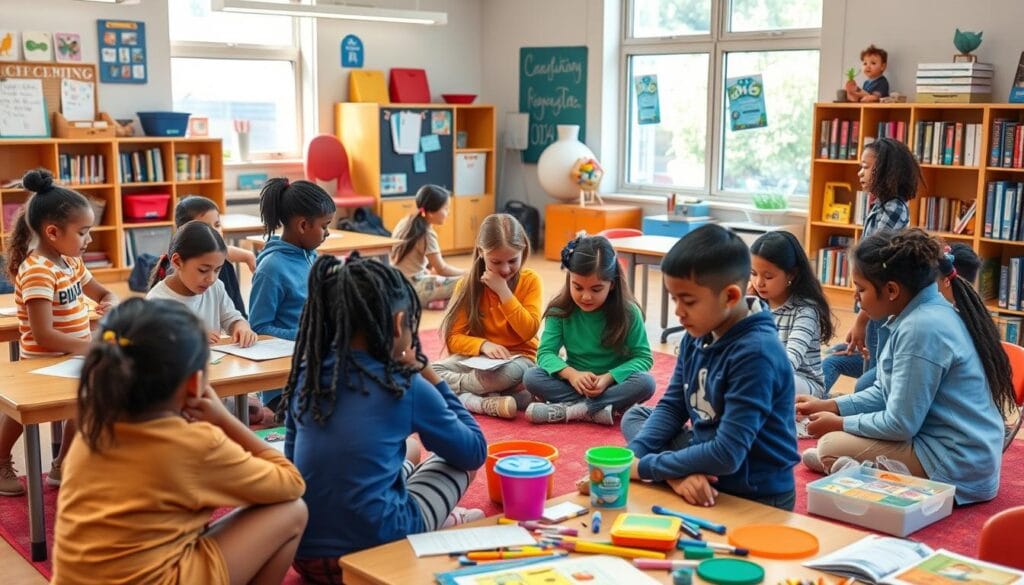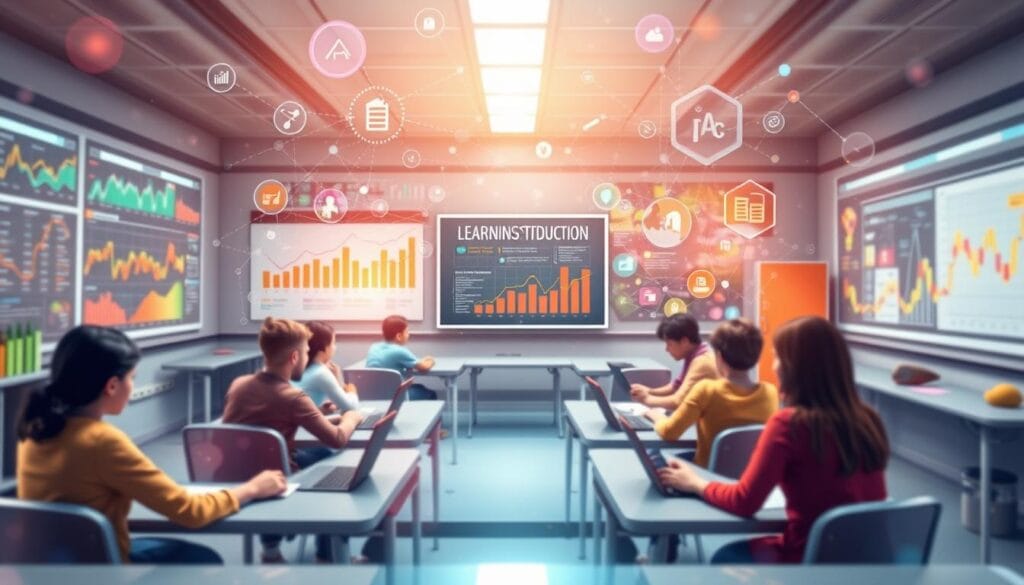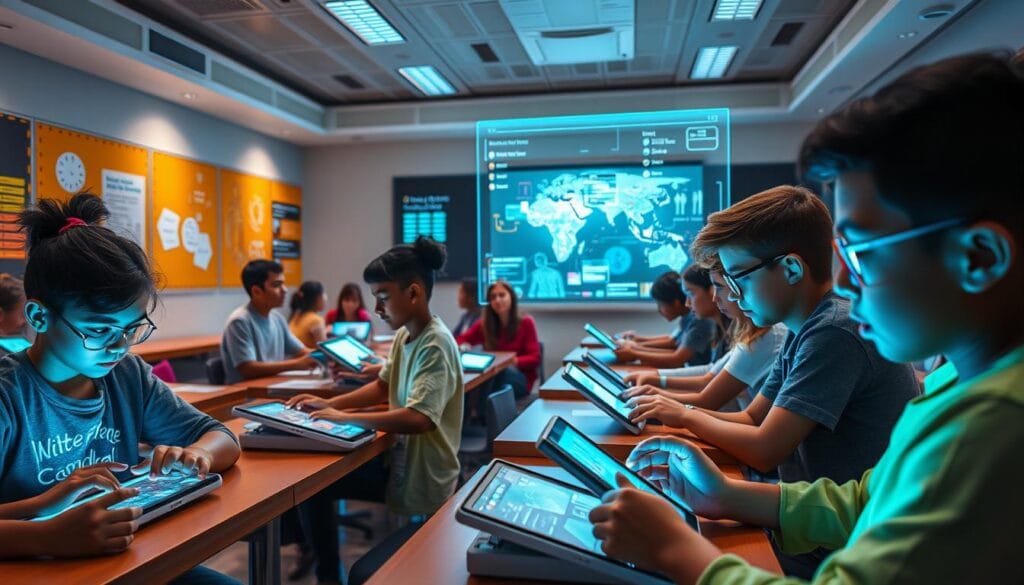Learning Progressions and Differentiation
In today’s changing world of education, learning progressions and differentiation are key. Teachers work hard to meet the needs of all students. This guide will show you how to adapt teaching, make learning personal, and use effective models in schools.
فهرس المقالة
Understanding the Foundations of Learning Progressions
Exploring the core principles of education is key for teachers. They aim to use competency-based learning, mastery learning, and student-centered approaches. This part looks at the main parts, building blocks, and thinking patterns that shape learning progressions.
Key Components of Educational Development
Learning progressions start with knowing how students get knowledge and skills. It’s about looking at cognitive development patterns that affect learning. Teachers can then plan lessons that meet students’ needs and help them learn deeply.
Building Blocks of Progressive Learning
- Mastery of foundational concepts and skills
- Scaffolding of knowledge and skills
- Opportunities for practice and application
- Feedback and guidance for continuous improvement
These blocks are the base for competency-based learning. Students move at their own speed and show they’ve mastered important skills. By focusing on students, teachers can make learning paths that let learners control their education.
Cognitive Development Patterns
It’s important to know the different ways students think and learn. This includes how age, past knowledge, and learning style affect understanding. By matching teaching methods to these patterns, teachers can help students understand and remember better.
“Understanding the fundamental principles of learning progressions is the key to creating personalized, student-centered education experiences that empower learners to reach their full potential.”
The Role of Differentiation in Modern Education
In today’s diverse educational landscape, differentiation is key. Personalized education and adaptive learning recognize that each student learns differently. By focusing on the student, teachers can help each one reach their full potential.
Differentiation means adjusting the content, process, and products of learning to meet students’ needs. This approach lets teachers create engaging and challenging lessons for everyone in the classroom.
- Differentiated instruction offers support, remediation, and enrichment, helping all students learn at their own pace.
- It gives students choices and flexibility, making them feel more in control of their learning.
- By tailoring teaching strategies and assessments, students gain a deeper understanding of important concepts, leading to better grades.
Embracing differentiation is crucial for a personalized education system. It helps every student grow and develop. By meeting the diverse needs in the classroom, teachers can unlock the full potential of adaptive learning and create a student-centered approach to education.
| Differentiation Strategy | Benefits |
|---|---|
| Content Differentiation | Adapting the curriculum to match students’ readiness levels, interests, and learning profiles |
| Process Differentiation | Providing a variety of learning activities and instructional approaches to accommodate diverse learning styles |
| Product Differentiation | Allowing students to demonstrate their understanding through a range of assessment formats and methods |
“Differentiation is not a strategy – it’s a way of thinking about teaching and learning.”
– Carol Ann Tomlinson, education consultant and author

Implementing Progression in Learning: Strategies and Approaches
Tracking student progress and measuring growth are key parts of data-driven instruction. Effective assessment methods and innovative tools help educators understand student learning. This understanding supports student growth and progress.
Assessment Methods for Progress Tracking
Formative assessments are vital in learning analytics. They give immediate feedback on student understanding and skills. Tools like exit tickets, classroom observations, and short quizzes help teachers see where students need help. This way, teachers can adjust their teaching to better meet student needs.
Tools for Measuring Student Growth
- Digital learning platforms that offer data-driven performance analytics and personalized learning pathways
- Learning management systems (LMS) that track student engagement, completion rates, and progress over time
- Adaptive assessment tools that adjust question difficulty based on student responses, providing a more accurate measure of their abilities
Documentation and Progress Monitoring
Keeping detailed records of student progress is crucial for data-driven instruction. Detailed documentation, like student portfolios, progress reports, and growth charts, helps teachers see patterns. It also helps them track individual student growth and make informed decisions to support their learning.
| Assessment Method | Advantages | Limitations |
|---|---|---|
| Formative Assessments | – Provide real-time feedback – Inform instructional adjustments | – Potential for inconsistency in scoring – Time-consuming to administer frequently |
| Adaptive Assessments | – Accurately measure student abilities – Offer personalized learning experiences | – Require specialized software and infrastructure – Potential for technical issues or glitches |
| Progress Monitoring | – Identify growth patterns over time – Facilitate data-driven decision-making | – Require consistent record-keeping – May not capture all aspects of student learning |
By using a mix of assessment methods, tools, and documentation, educators can support progressive learning. This approach helps monitor student growth. It supports learning analytics and data-driven instructional decisions.
Personalized Education Through Adaptive Learning Systems
In today’s digital world, education has changed a lot. Adaptive learning systems are leading this change. They make learning fit each student’s needs and learning style, offering personalized education.
Self-paced learning is at the core of these systems. They check how well a student is doing and adjust what they learn. This way, students can learn at their own speed, getting better at what they study.
| Key Benefits of Adaptive Learning Systems | Personalized Education Outcomes |
|---|---|
|
|
With adaptive learning systems, teachers can give each student a special learning experience. This new way of learning boosts grades and helps students learn on their own. It makes them strong and ready for more learning in the future.
“Adaptive learning systems have the potential to revolutionize the way we approach education, empowering students to unlock their full potential through personalized, self-paced learning.”
Mastery Learning: Ensuring Student Competency
In today’s education, mastery learning is becoming more popular. It aims for students to really understand and be good at what they learn, not just memorize it. Teachers set clear goals and check points to help students reach their best.
Establishing Clear Learning Objectives
The key to mastery learning is setting clear goals. These goals tell students what they need to know and do by the end of a lesson or course. Teachers use these goals to guide students and help them succeed.
Creating Mastery Checkpoints
Mastery learning uses regular feedback to help students improve. Teachers check how well students are doing and help where needed. This way, students only move on when they’ve really got it.
Remediation and Enrichment Options
Every student learns at their own pace. Mastery learning offers extra help when needed and more challenges for those who get it fast. This way, everyone gets the support they need.
By using mastery learning, teachers help students really get what they’re learning. This method encourages students to keep learning and growing. It helps them develop a love for learning and a desire to always improve.
Data-Driven Instruction in Learning Progressions
In today’s education, data-driven instruction is key for learning progressions. It uses learning analytics and formative assessments to understand students better. This helps teachers tailor their teaching to fit each student’s needs.
Formative assessments are important for tracking student progress. They give teachers feedback in real-time. This helps teachers spot where students need help and adjust their teaching.
Learning analytics also help teachers by analyzing lots of data. This data includes how students do in tests, how engaged they are, and their learning patterns. With this data, teachers can make better choices, teach differently, and create learning plans that fit each student.
| Metric | Description | Relevance to Learning Progressions |
|---|---|---|
| Formative Assessment Scores | Periodic evaluations that provide real-time feedback on student understanding and skill development. | Helps identify knowledge gaps and tailor instruction to individual needs. |
| Student Engagement Levels | Measures of student involvement, participation, and interaction during learning activities. | Informs adjustments to teaching strategies and learning environments to maintain student motivation and enthusiasm. |
| Learning Pace and Mastery Levels | Tracks the rate at which students acquire and demonstrate proficiency in specific skills and concepts. | Enables the implementation of personalized learning pathways and mastery-based learning approaches. |
By using data to guide teaching, educators can make learning better. This way, students can learn at their own speed and reach their highest potential.

Student-Centered Approaches to Educational Growth
In today’s education, a student-centered approach is key. It lets learners take charge of their learning. This way, students can learn in a way that fits them best.
Empowering Student Choice
When we focus on students, we let them decide what and how they learn. This makes them feel more connected to their education. It boosts their motivation and helps them learn better.
Flexible Learning Pathways
Student-centered learning means no one learns the same way. Students can learn at their own speed. They can focus more on what’s hard and move faster on what’s easy. This makes learning more personal and effective.
Self-Directed Learning Strategies
Learning on your own is a big part of this approach. Students learn to manage their own learning. This helps them grow into lifelong learners, ready for whatever comes next.
By focusing on students, education becomes more engaging and effective. It lets students make choices, learn at their own pace, and develop skills for life. This prepares them for a future where they can adapt and grow on their own.
| Approach | Key Elements | Benefits |
|---|---|---|
| Student-Centered |
|
|
“Education is not the filling of a pail, but the lighting of a fire.” – William Butler Yeats
By using a student-centered approach, teachers can spark curiosity. They empower students to be active and self-directed. This prepares them for success in a changing world.
Integrating Technology in Learning Progression Models
Technology is now key in education, making learning better for students. Adaptive learning and data-driven instruction help teachers tailor lessons for each student. This way, every student gets what they need to learn.
Learning analytics tools are a big help. They gather and analyze data on how students learn. This info lets teachers adjust their teaching to better meet student needs.
- Adaptive learning algorithms that adjust content and pacing based on individual student performance
- Real-time data visualization dashboards to track student progress and identify learning trends
- Personalized recommendations for remediation or enrichment activities to support each student’s unique needs
Using technology in learning models makes education more engaging and effective. Students get lessons that fit them, feedback that helps, and can learn at their own speed. This leads to better grades and more success.
“Technology is not just a tool, but a powerful enabler of personalized learning experiences that can transform the way we approach education.”
As education keeps changing, using adaptive learning, learning analytics, and data-driven instruction will be key. It will help create learning models that focus on students. These models will prepare students for the challenges of the 21st century.

Creating Effective Learning Analytics Frameworks
To unlock the power of data-driven instruction, you need strong learning analytics frameworks. These frameworks help educators make smart choices and track student progress well. By using a wide range of data collection, performance metrics, and progress reporting, you can get valuable insights. These insights help you improve your teaching and make learning more personal for your students.
Data Collection Methods
Use many different ways to collect data, like formative assessments, classroom observations, and digital learning platforms. This approach gives you a full picture of how students are doing. It lets you understand both the details and the big picture of their learning journey.
Performance Metrics and Indicators
Create a mix of performance metrics and indicators that look at more than just grades. Include things like critical thinking, problem-solving, and other important skills. By tracking these, you can really see how students are growing. This helps you know where to focus your efforts to help them even more.
Progress Reporting Systems
Set up systems that show how students are doing to everyone involved, like parents, administrators, and the students themselves. These systems should give clear, data-based information. This information helps everyone make better choices and work together to support each student’s learning path.
FAQ
What are learning progressions and how do they contribute to educational success?
Learning progressions are a step-by-step plan for what students should learn over time. They help teachers tailor lessons to fit each student’s needs. This approach supports personalized learning and helps students grow academically.
How does differentiation enhance modern educational approaches?
Differentiation means adjusting teaching and materials to meet different student needs. It helps create learning experiences that engage students and help them succeed. This way, students can reach their full potential.
What are the key components of effective learning progression models?
Good learning progression models have clear goals, checkpoints, and assessments. They also use data and adaptive systems. These elements help track student progress and support their growth.
How can data-driven instruction support learning progressions?
Data-driven instruction uses analytics and assessments to guide teaching. It helps teachers adjust lessons based on student performance. This way, they can better support each student’s learning journey.
What are the benefits of student-centered approaches to educational growth?
Student-centered learning gives learners control over their education. It promotes flexible learning and self-directed strategies. This approach boosts engagement and academic success, teaching important life skills.
How can technology enhance learning progression models?
Technology, like adaptive learning platforms, can greatly improve learning progressions. It personalizes instruction and tracks student progress. This technology helps teachers make informed decisions to support each student’s unique needs.






